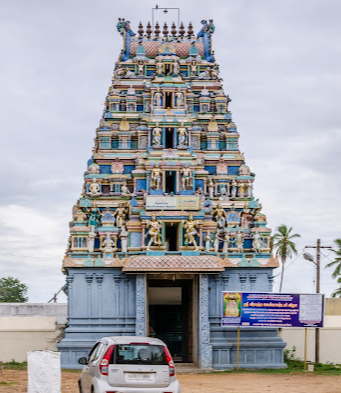As a devotee of Lord Shiva, Daksha received boons that ultimately led to his pride. He organised a grand yajna (sacrificial ritual) without inviting Lord Shiva, which resulted in Shiva withdrawing the boons he had granted him. Consequently, the place became known as Tiru Parialur. It is significant to note that Daksha was the father of Dakshayani, the consort of Lord Shiva. Due to his failure to adhere to the proper formalities in honouring the boon giver, Lord Shiva destroyed Daksha and his yajna. Other invitees, including the Devas, were also punished for accepting Daksha’s invitation while knowing that he had erred in ignoring Lord Shiva. The Sun God suffered a consequence as well, losing a tooth, and he is now enshrined in the temple, worshipping the Lord daily to atone for his mistake.
Sthala Puranam :
This temple, steeped in rich mythology, is intricately connected to the Daksha Yagam, a significant event in Hindu cosmology that intertwines with the stories of the Nangur Ekadasa Divya Desam and the Ekadasa Rudra Peetham. The legend begins with Lord Shiva's first marriage to Sati (Dakshayani), the daughter of Daksha. Initially, Daksha was a devoted follower of Shiva, but as he received numerous blessings and boons, he became egotistical and began to disrespect the Devas and celestial beings, including Lord Shiva.
To insult Shiva explicitly, Daksha organised a grand yagam (sacred fire ceremony) without inviting him. Despite Shiva's objections, Sati insisted on attending her father's yagam. When she arrived, she encountered insults directed at both herself and her husband. In her anguish, Sati warned Daksha about the repercussions of his actions. However, feeling humiliated, she immolated herself in the sacrificial fire.
In his fury over Sati's death, Lord Shiva unleashed Veerabhadra, a fierce incarnation, to punish Daksha. As a result of this wrath, Daksha was decapitated at this sacred site. However, upon realising his folly and repenting, Daksha was granted a new life, albeit with a goat's head replacing his own. This act symbolised the restoration of balance and the recall of the benefits previously bestowed upon him by Shiva. In Tamil, the term "Pari" means "to take back," which is reflected in the name of this location, Pariyalur.
The temple tank is believed to be the spot where Daksha was decapitated, and it is said that when the tank dries up, the altar where the event occurred becomes visible.
Administration History :
The temple's administration has evolved over centuries, starting with the original management during the Pandya period, followed by oversight during the Chola era. Inscriptions from the Sundara Pandyan and Krishnadevaraya periods indicate local governance and land grants for temple sustenance. Currently, the temple is managed under the Hindu Religious and Charitable Endowments Department of the Government of Tamil Nadu, ensuring its maintenance and continued spiritual significance. The recent renovations and the Maha Kumbhabhishekam in 2011 mark ongoing efforts to preserve its heritage.
